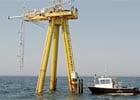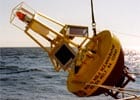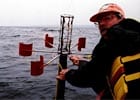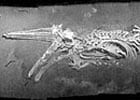Observing Systems & Sensors
Observatories are becoming more popular for continuous, long-term monitoring of ocean and meteorological processes. These observation systems are stable platforms from which a variety of data such as water temperature, wave height, wind and current speed is collected and fed back to scientists for analysis.

Martha's Vineyard Coastal Observatory
The Martha's Vineyard Coastal Observatory (MVCO), located at South Beach in Edgartown, Massachusetts, provides real-time data on coastal oceanic and meteorological processes while contributing to a larger network of observatories along the east coast. Data is displayed through the internet, providing a means for public outreach and educational programs.
» Martha's Vineyard Coastal Observatory

Moored Observation Systems
Moored observation systems or buoys provide long-term oceanographic and meteorological data to scientists and the general public. Conductivity or salinity sensors are attached to moorings at different depths for comparative data. Moorings can also accommodate Acoustic Doppler Current Profilers (ADCPs) to measure currents through the water column. Data from buoys are available in real-time through the internet.
» Ocean Observatories Initiative (OOI)
» Mooring Operations & Engineering (MOE)
» Mooring Lab
» U.S. GLOBEC Long-term Moored Program
» National Data Buoy Center

Sensors and Instruments
AOPE engineers and scientists develop sensors and instruments to collect data on anything from ocean currents and flows to gas exchange between the ocean and atmosphere.
» Autonomous Vehicles & Sensor Technologies (AVAST)
» Micromodem
» Underwater Acoustic Projector
» Deep Submergence Laboratory (DSL)
» Advanced Engineering Laboratory (AEL)

Optical and Acoustic Imaging Systems
Acoustic imaging systems provide pictures and maps of the seafloor so that scientists may obtain valuable information on hydrothermal vents, ocean processes or shipwrecks. Acoustic imaging is also used to determine biological activity within ocean waters.
» Underwater Photomosaicking
» Advanced Imaging & Visualization Laboratory
» Deep Submergence Laboratory (DSL)
